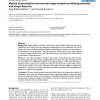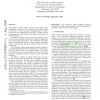8728 search results - page 1665 / 1746 » On Reduct Construction Algorithms |
BMCBI
2004
13 years 9 months ago
2004
Background: Hidden Markov Models (HMMs) have proven very useful in computational biology for such applications as sequence pattern matching, gene-finding, and structure prediction...
BMCBI
2004
13 years 9 months ago
2004
Background: Recent genomic and bioinformatic advances have motivated the development of numerous network models intending to describe graphs of biological, technological, and soci...
BMCBI
2004
13 years 9 months ago
2004
Background: Image analysis is the first crucial step to obtain reliable results from microarray experiments. First, areas in the image belonging to single spots have to be identif...
CORR
2004
Springer
13 years 8 months ago
2004
Springer
We introduce regular graph constraints and explore their decidability properties. The motivation for regular graph constraints is 1) type checking of changing types of objects in ...
BMCBI
2002
13 years 8 months ago
2002
Background: Most profile and motif databases strive to classify protein sequences into a broad spectrum of protein families. The next step of such database studies should include ...


